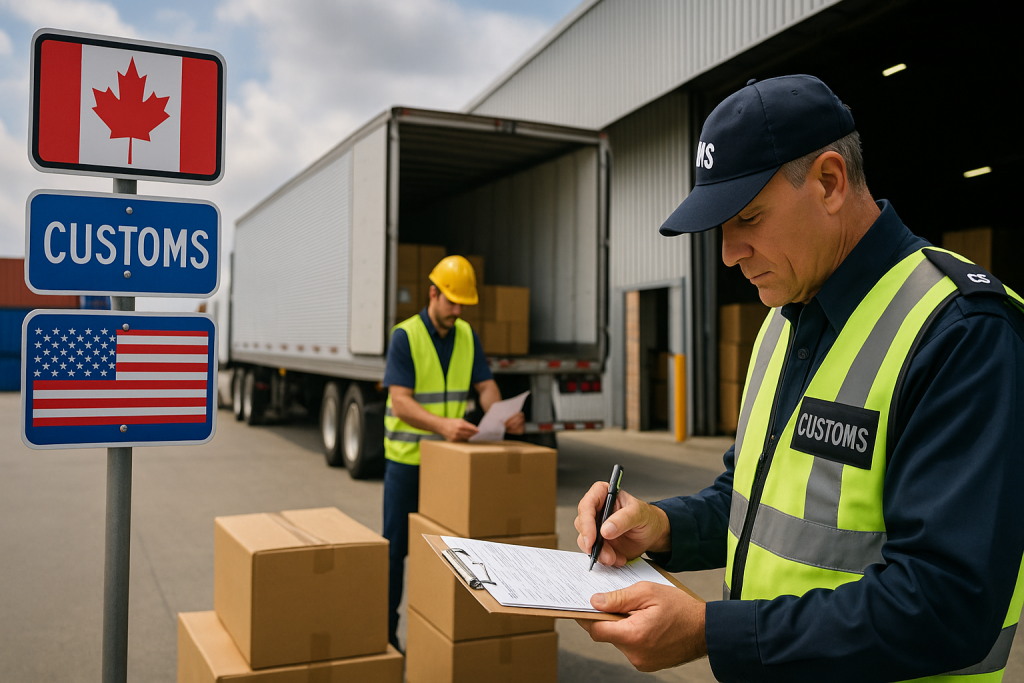By Martin Vassilev / 17 Nov, 2025
Shipping from Canada to the United States remains one of the most active and lucrative trade routes in North America—but it’s also one of the most heavily regulated. Even minor documentation errors, incorrect tariff classifications, or incomplete declarations can add days (or weeks) to your delivery timeline. For businesses competing in fast-moving markets, customs delays lead to increased operational costs, customer dissatisfaction, and damaged supply chain performance.
This comprehensive guide outlines the most effective strategies, best practices, and compliance procedures to help Canadian businesses ship to the U.S. without delays. Every section is optimized with actionable insights, authoritative resources, and internal linking to related logistics and warehousing guides that help strengthen your overall shipping workflow.
To successfully avoid customs-related delays, businesses must understand what triggers the most common problems at the border. U.S. Customs and Border Protection (CBP) enforces strict rules to protect the domestic market and ensure security. Delays often stem from:
Missing or incomplete commercial invoices
Incorrect HS (Harmonized System) codes
Undervaluation or inconsistent declared values
Restricted or prohibited items
Missing certificates of origin
Misclassified shipments (documents vs. goods)
Insufficient product descriptions
Carrier miscommunication or incomplete documentation
Failing to comply with U.S. regulatory agency requirements (FDA, USDA, FCC, etc.)
Understanding these fundamentals ensures your goods move smoothly through customs, especially when integrated with efficient logistics processes like cross-docking or real-time inventory systems, explained in detail in resources such as Calgary–Dallas logistics hubs and How AI is transforming logistics.
The commercial invoice is the primary document U.S. customs officials inspect. It must include:
Full seller and buyer details
A complete and specific product description
HS codes
Quantity and weight
Country of origin
Line-item pricing
Incoterms
Signature and date
Improper or vague descriptions are among the top reasons for customs holds. For example, “parts” is not acceptable—customs requires specific identification like “aluminum automotive brake components.”
Businesses optimizing their supply chains often pair strong documentation processes with advanced warehouse technologies. See how automation improves reliability in the guide on Integrating AI in warehouse management.
HS codes determine duties, taxes, and entry requirements. Incorrect codes trigger:
Inspection delays
Reclassification
Fines
Seizures
Rejected entries
To ensure precision:
Match products with the correct 6-digit HS code.
Use the Canadian Customs Tariff as a reference.
Cross-check with the U.S. Harmonized Tariff Schedule.
Consult customs brokers for specialized products.
You can reference official U.S. government resources such as the U.S. International Trade Commission (USITC) for tariff classifications.
Customs agents are trained to flag:
Generic descriptions
Products missing material composition
Items without intended use
Goods with vague or abbreviated labels
The description should answer:
What is it? What is it made of? What is it used for? Who is the end user?
A strong description example:
“Men’s 100% cotton short-sleeve shirts, retail-ready, packed in 12-unit cartons.”
This reduces manual inspection and expedites clearance.
Delays frequently occur when the declared value appears inconsistent with market norms. Under-declaring value—even by mistake—creates suspicion and may lead to:
Full cargo examinations
Value verification audits
Additional document requests
Penalties
To prevent value-related delays:
Match invoice value with payment reports
Avoid round numbers unless justified
Provide proof of sale if requested
Include freight, insurance, and packaging charges accurately
Under the CUSMA/USMCA trade agreement, qualifying goods can enter the U.S. duty-free—but only with proper certification.
To qualify:
Goods must meet specific rules of origin
Documentation must be completed accurately
Certificates must match invoice details
Having accurate proof of origin supports smoother cross-border shipping, especially when your supply chain relies on precise fulfillment and warehousing workflows like those outlined in the guide on Optimizing your supply chain for global challenges.
The carrier you choose significantly affects customs outcomes. Professional logistics providers:
Pre-submit customs data
Validate documentation
Assist with HS codes
Provide real-time tracking
Offer customs brokerage arrangements
Companies with strong cross-border experience help prevent mistakes. For businesses that require advanced fulfillment or international shipping support, guides such as The Ultimate Guide to Efficient Shipping offer insights on choosing reliable partners.
Many products require additional clearance steps or are banned. Examples include:
Food and agricultural products (USDA restrictions)
Cosmetics or supplements (FDA clearance)
Electronics with communication features (FCC clearance)
Hazardous materials
Firearms or parts
Lithium batteries
Before shipping, always verify compliance through:
U.S. Customs and Border Protection (CBP).

Conducting thorough checks before shipping can eliminate up to 80% of customs issues:
Validate all invoices
Confirm HS codes
Review import restrictions
Check recipient EIN requirements
Determine whether FDA, USDA, FCC, or DOT applies
Confirm tariff or duty obligations
Verify packaging and labeling standards
Many businesses integrate compliance checks into warehouse operations using predictive analytics—highlighted in the resource on How AI is transforming logistics.
Transportation carriers must submit advance manifest data before the shipment reaches U.S. borders. If any data is missing, customs can:
Issue holds
Require re-submission
Delay entry
Force inspection
Make sure carrier manifests include:
Accurate shipper and consignee info
Exact commodity description
Weight and packaging details
Port of entry
Tariff numbers
Businesses that rely on cross-border shipping benefit greatly from real-time tracking systems. These systems allow you to:
Track shipments as they move through customs
Receive compliance alerts
Access digital copies of required documents
Stay updated on detention or examination status
You can learn more about modern tracking solutions at Real-time tracking in delivery services.
Many customs delays originate from upstream issues—warehouse labeling errors, incorrect packing lists, or poorly managed inventory data. Smart warehouse practices reduce these risks:
Automated labeling
Barcode and RFID scanning
Proper cartonization
Real-time inventory accuracy
Automated compliance flags
Warehousing optimization strategies are detailed in resources like How to Improve Warehouse Space Utilization.
Customs brokers handle:
HS code determination
Trade compliance
Duty and tariff calculations
Filing customs entries
Coordinating with CBP
Completing USMCA requirements
Brokers significantly reduce delays, especially for growing businesses that lack internal customs knowledge.
Not all inspections can be avoided—but many can be sped up.
Ensure packaging is secure and accessible
Label boxes clearly
Keep documentation attached
Avoid mixing different product types in one carton
Maintain digital copies of all paperwork
By preparing for inspections, you prevent unnecessary delays and reduce handling time.
Incorrect HS codes
Undervaluation or missing values
Incomplete invoices or missing details
Shipping restricted goods without proper permits
Carrier manifest errors or omissions
Addressing these issues ensures smooth border crossing.
Accurate documentation—especially correct HS codes and detailed invoices—is the most effective way to avoid delays. Using a customs broker further reduces risks.
Yes. Every shipment entering the U.S. from Canada requires a commercial invoice and proper classification.
CBP can hold shipments for security checks, random inspections, or verification of documents at any time.
No. The U.S. de minimis threshold applies primarily to personal imports under $800.
Most shipments clear within hours, but documentation issues can extend delays to several days.

“Thanks to Byexpress all my shipping and fulfillment costs are in line now”

“All my issues were solved by Byexpress team that I had with pervious 3pl provider.”

“Thank you Byexpress team could not done it without you guys.”

“Their integration and customer service were the key for me”

“Outstanding delivery service! The package was well-packaged, and
the delivery team was professional and courteous”

“Great and knowledgeable team to work with.”

Thanks, guys, for reducing my shipping rates
Ottawa Office
2411 Holly Lane
Ottawa, ON, K1V 7P2
Toronto Office
13-280 West Beaver Creek Road Unit #136
Richmond Hill, ON, L4B 3Z1
Alexandria Office
173 Kenyon Street West
Alexandria, ON, K0C 1A0
Montreal Office
4388 Saint-Denis Street Unit #200
Montreal, QC, H2J 2L1
California Office
155 North Riverview Drive
Anaheim Hills, CA, 92808
Call Us
Toll-Free: 1-866-744-7122
Local : 613-739-3000
Email Us
Multilingual Services










